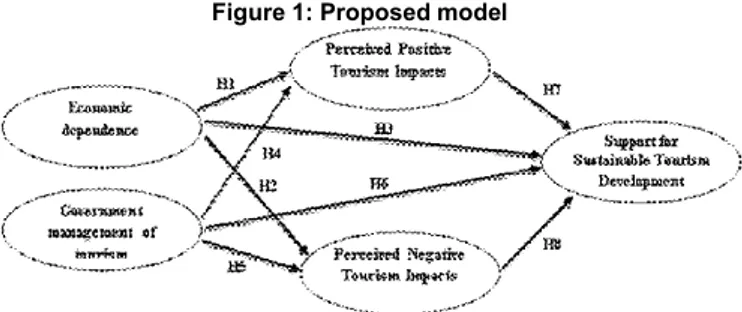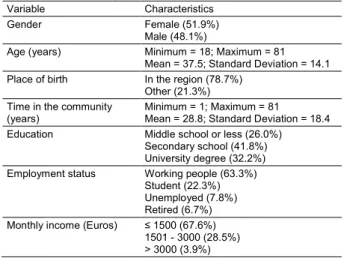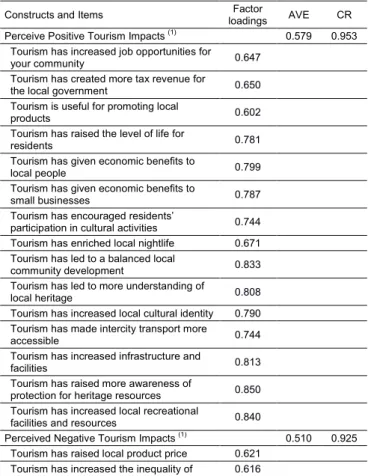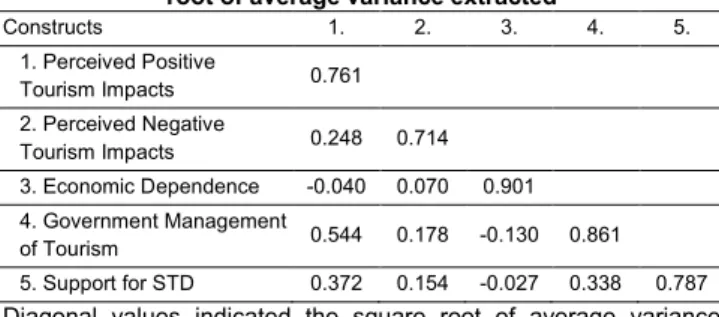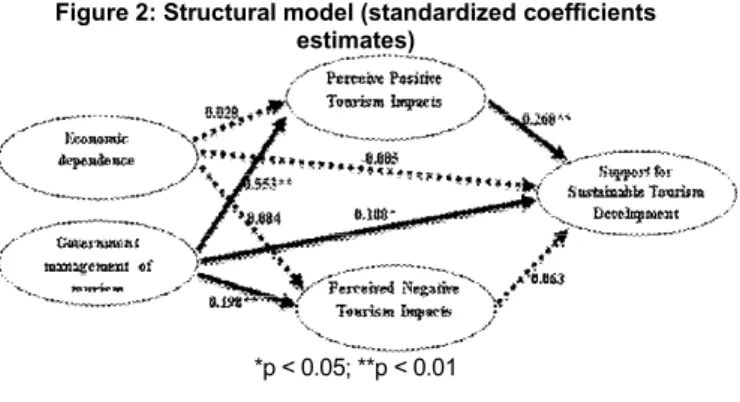2
CONFERENCE PROCEEDINGS OF THE
INTERNATIONAL CONFERENCE ON
TOURISM (ICOT 2015)
From Tourism Policy into Practice:
Issues and Challenges in Engaging Policy
Makers and End Users
London 24-27June 2015
EDITOR
Konstantinos Andriotis
Middlesex University London, U.K.k.andriotis@mdx.ac.uk
©
Table of contents ______________________________________________________________________________ TABLE OF CONTENTS CONFERENCE AIM ... 7 CONFERENCE TOPICS ... 9 COMMITTEES ... 10 KEYNOTE SPEAKERS ... 12
Prof. Peter Burns ... 12
Emeritus Professor Carson L. Jenkins ... 13
Professor Allan Williams ... 14
SCHEDULE AT A GLANCE ... 15
THE MODERATING ROLE OF POSITIONAL LEVEL AND EXPERIENCE BETWEEN EMPLOYEES' JOB SATISFACTION AND TURNOVER: EVIDENCE FROM HOTELS IN SAUDI ARABIA Hany Hosny Sayed Abdelhamied ... 17
TORREMOLINOS: ANALYSIS OF HOTEL INDUSTRY AND URBAN CHANGE IN A MATURE SEASIDE DESTINATION Fernando Almeida-García, Rafael Cortes-Macias and Antonia Balbuena-Vazquez ... 34
EVALUATION OF ECONOMIC INFLUENCE OF TOURISM DEVELOPMENT ON THE HOST COMMUNITIES OF CROSS - RIVER NATIONAL PARK NIGERIA Enemuo Ogechi Blessing and Chigozie Igwe Esther ... 50
CONCEPTUALISING YOUTH TOURISM IN ISLAND DESTINATIONS: THE CASE OF AYIA NAPA AND PROTARAS, CYPRUS Nikolaos Boukas and Christakis Sourouklis ... 65
ISLANDS’ TOURIST DEVELOPMENT AND LOCAL RESIDENTS’ PROSPERITY: REALITY OR AN UNSOLVED PROBLEM?
Nikolaos Boukas and Vassilios Ziakas ... 75
INVESTIGATING E-COMPLAINTS ON SEA-SIDE RESORT HOTELS: EVIDENCE FROM SHARM EL-SHEIKH, EGYPT Mohammed M. El-Dief and Ghada M. El-Dief ... 85
SMARTPHONE USAGE, ADDICTION DURING A HOLIDAY ... 98
Mehmet Emek ... 98
TOURISM ACTIVITIES, SOCIAL INTERACTION AND THE IMPACT OF TOURISM ON YOUTH TOURISTS’ QOL: A STRUCTURAL EQUATION MODEL Celeste Eusébio, Maria JoÃo Carneiro and Ana Caldeira ... 109
EXPANDING THE ICELANDIC TOURISM SATELLITE ACCOUNT AND ITS POSSIBILITIES OF USING FOR TOURISM POLICY Cristi Frent ... 125
TOURISM AND POLYCENTRIC DEVELOPMENT IN URBAN AND RURAL AREAS. CASE STUDY: TRIPLE-POLE PROPOSALS IN BACĂU AND CLUJ COUNTIES (ROMANIA)
George Gaman, Bianca Sorina Răcăşan and Alexandra Camelia Potra ... 139
Table of contents
______________________________________________________________________________
4
INCREASING THE INNOVATIVENESS OF TOURISM FIRMS: THE ROLE OF ACADEMIC RESEARCH
Kirsti Mathiesen Hjemdahl, Tor Helge Aas and Sarah Holst Kjær ... 154 TRAVEL BEHAVIOUR IN INTERNATIONAL STUDENT
LANGUAGE TOURISM
Montserrat Iglesias ... 167 BARRIERS TO IMPLEMENTING AN EFFECTIVE TOURISM POLICY FOR THE KOREAN WAVE: FROM THE GOVERNMENT PERSPECTIVE
Sangkyun Kim and Chanwoo Nam ... 180 OPPORTUNITIES AND CHALLENGES FOR THAILAND MEDICAL TOURISM INDUSTRY OF NURSING CARE FOR THE ELDERLY
Klimenko Roman ... 193 DESTINATION IMAGE: AN ANALYSIS OF CEPHALONIA’S TOURIST PERCEPTIONS - ATTITUDES
Anna Kyriakaki, Lampros Banis, Theodoros Stavrinoudis and Maria Doumi ... 207 FILM AND GASTRO TOURISM: AN OVERVIEW OF RECENT TRENDS
Sara Lindén ... 221 MANIFESTATION OF VALUES AND IDENTITY IN TRAVELLING
Darius Liutikas... 233 KNOWLEDGE-BASED TOURISM POLICY FORMULATION, AS AN APPLICATION OF OPEN DATA IN CARIBBEAN TOURISM ...
Michelle McLeod and Maurice McNaughton ... 246 TOURISM AND CHILD LABOUR: SOCIAL IMPLICATIONS IN THE MONARCH BUTTERFLY RESERVE IN MEXICO
Carlos Monterrubio, Gregoria Rodriguez-Muñoz and uana M. Duran-Barrios ... 258 A CRITICAL ANALYSIS OF MIGRATION-TOURISM
RELATIONSHIP FROM MOBILITY PERSPECTIVE: A STUDY OF BANGLADESHI MIGRANTS IN THE UK
MD Farid Miah and Vipin Nadda ... 269 A HEURISTIC TECHNIQUE FOR SELECTING SARIMA MODELS FOR FORECASTING TOURISM TIME SERIES
Ioannis A. Nikas and Alkiviadis Panagopoulos ... 282 SERVICE QUALITY IN CROSS BORDER REPRODUCTIVE CARE (REPRODUCTIVE TOURISM) IN GREECE: PRIVATE SECTOR
Despina Karayanni and Gerasimos Panas ... 296 THE INFLUENCE OF A LOCAL COMMUNITY’S EMPOWERMENT ON ITS PERCEPTION OF COMMUNITY-BASED ECOTOURISM IN A PROTECTED AREA
BOOK OF ABSTRACTS OF THE INTERNATIONAL CONFERENCE ON TOURISM (ICOT2015): From Tourism Policy into Practice: Issues and Challenges in Engaging Policy Makers and End Users London 24-27 June 2015
______________________________________________________________________________ INTERACTIONS AND RELATIONSHIPS BETWEEN VOLUNTEER TOURISTS AND HOSTS: A CASE OF THE SPECIAL
EDUCATION CENTRE OF RANONG PROVINCE
Raweewan Proyrungroj ... 324 A THEORETICAL FRAMEWORK TO EVALUATE COASTAL DESTINATION VULNERABILITY TO CLIMATE CHANGE THROUGH POLICY ANALYSIS
Raquel Santos-Lacueva, Salvador Anton Clavé, Òscar Saladié and Stephen J. Page ... 336 HOST COMMUNITY RESILIENCE TO NIGHCLUB TOURISM
Antoni Serra Cantallops and José Ramón Cardona... 348 EASING LIQUOR REGULATIONS IN THE BIBLE-BELT: THE EMERGENCE OF CRAFT BEER TOURISM
Susan L. Slocum ... 361 THE EFFECT OF EMPLOYEE EDUCATION-TRAINING ON HRM PERFORMANCE IN THE HOTELS OF ATTICA
Theodoros Stavrinoudis and Moschos Psimoulis ... 373 GOVERNMENT MANAGEMENT OF TOURISM IN FOSTERING RESIDENTS SUPPORT FOR SUSTAINABLE TOURISM
DEVELOPMENT: EVIDENCE FROM A PORTUGUESE HISTORIC TOWN
Isabel Vieira, Ana Rodrigues, Didiana Fernandes and Carlos Pires... 388 INDIVIDUAL PERCEPTIONS OF THE VALUE OF LEISURE TIME: DEMOGRAPHICS, ATTITUDES, AND COUNTRY
DEVELOPMENT LEVELS
Craig Webster, Chih-Lun Yen, Sotiris Hji-Avgoustis and Kelsey Shapiro ... 400 WHAT MATTERS IN A HOTEL IN CENTRAL AUSTRALIA? CLUES FROM CUSTOMERS’ ONLINE REVIEWS
Benxiang Zeng ... 412 SPECIAL SESSION 1: PLACE MARKETING AND
SUSTAINABILITY
Οrganised by: Dimitrios Stylidis and Matina Terzidou ... 426 PLACE BRAND MANAGEMENT AS THE PROCESS OF
REALIZING A PROFITABLE DESTINATION
Sarah Holst Kjær, Tor Helge Aas and Kirsti Mathiesen Hjemdahl ... 427 BIG DATA ANALYSIS SOLUTIONS FOR SUPPORTING
TOURIST’S DECISION MAKING
Eleonora Pantano and Gianpiero Di Blasi... 440 SPECIAL SESSION 2: POLITICAL SYSTEM: THE DRIVER OF TOURISM POLICY
Οrganised by: Amitabh Upadhya ... 453 INNOVATION PRACTICES IN PERFORMING ARTS AND CULTURE ORGANIZATIONS
Tor Helge Aas, Kirsti Mathiesen Hjemdahl and Sarah Holst Kjær ... 455
Table of contents
______________________________________________________________________________
6
POLITICAL IDEOLOGIES AS SHAPERS OF FUTURE TOURISM DEVELOPMENT
Craig Webster and Stanislav Ivanov ... 467 SPECIAL SESSION 3: PILGRIMAGE AND PILGRIMS:
JOURNEYS, DESTINATIONS, MEANINGS
Οrganised by: Noga Collins-Kreiner ... 479 THE HISTORICAL ROOTS OF THE HOLY LAND GUIDE: PERSONAL AND TEXTUAL GUIDES FROM THE FOURTEENTH TO THE TWENTY-FIRST CENTURIES
GOVERNMENT MANAGEMENT OF TOURISM IN FOSTERING RESIDENTS SUPPORT FOR SUSTAINABLE TOURISM DEVELOPMENT: EVIDENCE FROM A PORTUGUESE HISTORIC TOWN
_____________________________________________________________________________
GOVERNMENT MANAGEMENT OF TOURISM
IN FOSTERING RESIDENTS SUPPORT FOR
SUSTAINABLE TOURISM DEVELOPMENT:
EVIDENCE FROM A PORTUGUESE HISTORIC
TOWN
I
SABELV
IEIRAPolytechnic Institute of Viseu, Portugal
A
NAR
ODRIGUESUniversity of Trás-os-Montes and Alto Douro, Portugal
D
IDIANAF
ERNANDES Polytechnic Institute of Viseu, PortugalC
ARLOSP
IRESUniversity of Trás-os-Montes and Alto Douro, Portugal
This study explores the interrelationships between tourism dependence, government management of tourism, perceived tourism benefits and perceived tourism costs, and support for sustainable tourism development (STD). A quantitative research design was adopted. The data collection was performed through a personal survey conducted to 300 residents of a small historic town within the Douro World Heritage Site (Lamego town).The results suggest that government management of tourism has a positive and significant impact on perceived tourism benefits and costs. The effect of government management of tourism in fostering residents support for STD was also empirically supported. Additionally, the effect of perceived tourism benefits on residents support
BOOK OF ABSTRACTS OF THE INTERNATIONAL CONFERENCE ON TOURISM (ICOT2015): From Tourism Policy into Practice: Issues and Challenges in Engaging Policy Makers and End Users London 24-27 June 2015
______________________________________________________________________________
- 389
for STD was also supported empirically. However, economic dependence on tourism does not have a significant effect either on perceived benefits, on perceived costs or on the residents support for STD. Also, perceived negative impacts are not a predictor to measure support for STD.
1. Introduction
Tourism is an activity of strategic importance in most countries in their economic, social and environmental aspects. We have been witnessing to a growing interest in sustainable tourism development (STD), either by public and private bodies. To develop tourism in a sustainable manner it is vital the participation of relevant stakeholders as well as strong political leadership. It is an ongoing process that requires constant monitoring of impacts, so it is crucial the existence of an adequate planning process and adjusted to local conditions and an effective and continuous management of tourism activities.
There is increasing interest in literature on the residents support for STD (Ko and Stewart, 2002) and its antecedents. Understanding the antecedents of residents support for STD is crucial both for local government and policy makers and tourism businesses. The success of any effort of sustainable development depends on an active support from local communities (Gursoy and Rutherford, 2004). However, to the best of our knowledge, there are few studies that analyse the residents support for STD in historic towns, especially in relation with economic dependence, management government of tourism and perceived tourism impacts.
The main aim of this study is to gain an insight into residents’ perceptions about economic dependence, government management of tourism and perceive tourism impacts and the role it has in supporting STD.
In the remaining parts of this paper, the conceptual framework and research hypotheses are reviewed. The methodology is then explained and the results are explored. Finally, some conclusions are presented.
GOVERNMENT MANAGEMENT OF TOURISM IN FOSTERING RESIDENTS SUPPORT FOR SUSTAINABLE TOURISM DEVELOPMENT: EVIDENCE FROM A PORTUGUESE HISTORIC TOWN
_____________________________________________________________________________
2. Theoretical Overview and Proposed Hypotheses
Over the past several decades, interest in tourism as a tool for regional economic development has grown dramatically. Community leaders and economic development specialists have increasingly treated tourism as an important industry that can enhance local employment opportunities, tax revenues, and economic diversity (Kim, Uysal, and Sirgy, 2013).
Several studies related the positive and negative effects of tourism on economic well-being of tourism communities (e.g., Allen et al., 1994; Liu, Sheldon, and Var, 1987; Perdue, Long, and Allen, 1987; Sheldon and Var, 1984; Um and Crompton, 1987).
Economic impacts include positive elements such as tax revenue, increased jobs and additional income, as well as negative elements such as tax burdens, inflation and local government debt (Chen and Chen, 2010).
Economic dependency is defined as residents’ and/or their family household income is dependent on tourism-related business (Perdue, Long, and Allen, 1990). Few studies were examined the influences of community tourism development level and tourism industry dependency on tourism impact perception (Gursoy, Jurowski, and Uysal, 2002).
Some studies have found a positive and significant effect on resident attitudes, where those standing to gain more financially from tourism tend to have more positive attitudes towards tourism (Harril, 2004; Ko and Stewart 2002; McDowall and Choi, 2010; Perdue, Long, and Allen, 1990).
Therefore, the following hypotheses are proposed:
H1: There is an effect between economic dependence and the perceived positive tourism impacts.
H2: There is an effect between economic dependence and the perceived negative tourism impacts.
H3: There is an effect between economic dependence and the residents support for STD.
The government management of tourism has a key role in the building of a sustainable model for the destination (Gorica, Kripa, and Zenelaj, 2012). Assante, Wen, and Lottig (2012), tested and confirmed empirically the positive relationship
BOOK OF ABSTRACTS OF THE INTERNATIONAL CONFERENCE ON TOURISM (ICOT2015): From Tourism Policy into Practice: Issues and Challenges in Engaging Policy Makers and End Users London 24-27 June 2015
______________________________________________________________________________
- 391
between public management of tourism and the perception about the environmental impacts of tourism and concluded that residents tend to be more receptive to tourism impacts when they feel that the government makes effective management.
On the other hand, we can expect the existence of a relationship between the government management of tourism and the residents support for STD.
Assante, Wen, and Lottig (2012) argue that government management and stakeholders’ cooperation are needed to achieve consensus on how to manage future tourism developments. The authors conclude that if residents perceive that there is effective management in control of tourism, on the part of public administration agents tend to have positive feelings about the STD. Having regard to the above, we established the following hypotheses:
H4: There is an effect between the effective government management of tourism and the perceived positive tourism impacts.
H5: There is an effect between the effective government management of tourism and the perceived negative tourism impacts
H6: There is an effect between the effective government management of tourism and the residents support for STD.
Over the past two decades several authors have conducted studies on the relationship that can be established between the perception on the part of residents, the tourism impacts and their support for the development of tourism (Gursoy, Jurowski, and Uysal, 2002; Gursoy and Rutherford, 2004; Ko and Stewart, 2002; Nicholas, Thapa, and Ko, 2009; Sharma and Dyer, 2009). These studies, based on the social exchange model, suggest that residents with a perceived positive impact (benefits, for example) are more likely to support the development of tourism. In this context, we established the following hypotheses:
H7: There is an effect between the perceived positive tourism impacts and the residents support for STD.
H8: There is an effect between the perceived negative tourism impacts and the residents support for STD.
Figure 1 shows the theoretical framework of this study and the hypotheses proposed.
GOVERNMENT MANAGEMENT OF TOURISM IN FOSTERING RESIDENTS SUPPORT FOR SUSTAINABLE TOURISM DEVELOPMENT: EVIDENCE FROM A PORTUGUESE HISTORIC TOWN
_____________________________________________________________________________
3. Methodological Approach
This study was conducted in a small historic town in northern Portugal (Lamego) within the Douro World Heritage Site. It is one of the most ancient towns in Portugal with different heritage that represents several historic stages. Considering the life cycle of the destination proposed by Butler (1980), this town is at its development stage, where the negative impacts of tourism are almost unnoticed by all those involved.
Figure 1: Proposed model
This study adopted a quantitative approach, in the form of a survey questionnaire administered to a sample of residents of the historic town of Lamego. Face-to-face survey administration was limited to a convenience sample distributed and collected at resident’s homes. A total of 300 completed questionnaires were collected.
In the questionnaire, we have analysed the perceptions of the local population in regard to: economic dependence, management government of tourism, perceived tourism impacts and support for STD. Scales that were used previously in tourism impact and STD studies were adopted to measure the constructs proposed in the study.
Economic dependence was operationalize through the scale developed by Chen and Chen (2010), with two items. We use the scale of Assante, Wen, and Lottig (2012) to measure government management of tourism, with three items. Perceive tourism impacts (positive and negative) were measure by Chen and Chen (2010) and the support for STD construct was operationalize by the scale developed by Lee
BOOK OF ABSTRACTS OF THE INTERNATIONAL CONFERENCE ON TOURISM (ICOT2015): From Tourism Policy into Practice: Issues and Challenges in Engaging Policy Makers and End Users London 24-27 June 2015
______________________________________________________________________________
- 393
(2013), which was based on the work of Nicholas, Thapa, and Ko (2009).
A 7-point Likert-type scale (1= strongly disagree; 7= strongly agree) was utilized in all of the variables except economic dependence (1= without relation; 7= totally related).
To test the hypothesized relationships between the constructs, we used the structural equation modeling technique. The descriptive analysis was performed using SPSS - version 22 for Windows, and the structural equation models using Amos - version 22 for Windows.
The socio-demographic characteristics of respondents are shown in Table 1.
Table 1: Sociodemographic characteristics of the sample Variable Characteristics
Gender Female (51.9%)
Male (48.1%)
Age (years) Minimum = 18; Maximum = 81 Mean = 37.5; Standard Deviation = 14.1 Place of birth In the region (78.7%)
Other (21.3%) Time in the community
(years)
Minimum = 1; Maximum = 81
Mean = 28.8; Standard Deviation = 18.4 Education Middle school or less (26.0%)
Secondary school (41.8%) University degree (32.2%) Employment status Working people (63.3%)
Student (22.3%) Unemployed (7.8%) Retired (6.7%) Monthly income (Euros) ≤ 1500 (67.6%)
1501 - 3000 (28.5%) > 3000 (3.9%)
4. Results
The quality of the instruments was assessed using confirmatory factor analysis (CFA) through the estimation of a measurement model with the maximum likelihoodmethod.
To assess the convergent validity we analysed the standardized factor loadings, the average variance extracted (AVE) and the construct reliability (CR) (Table 2). The standardized factor loadings were all statistically significant (p < 0.001) and ranged from 0.602 to 0.912, above the cutoff point of 0.50 suggested by Hair et al (2010). The AVE measures the
GOVERNMENT MANAGEMENT OF TOURISM IN FOSTERING RESIDENTS SUPPORT FOR SUSTAINABLE TOURISM DEVELOPMENT: EVIDENCE FROM A PORTUGUESE HISTORIC TOWN
_____________________________________________________________________________
amount of variance explained by the construct and should be higher than 0.50. In this study, the AVE ranged from 0.510 and 0.812, above the cutoff point. The CR estimates, above 0.88, suggest high construct reliability, which indicates that internal consistency exists - meaning that all the measures consistently represent the same construct (Hair et al., 2010). These results constitute evidence of convergent validity of the constructs.
Table 2: Standardized factor loadings, average variance extracted (AVE) and construct reliability (CR) of the
measurement model
Constructs and Items loadings Factor AVE CR Perceive Positive Tourism Impacts (1) 0.579 0.953
Tourism has increased job opportunities for
your community 0.647
Tourism has created more tax revenue for
the local government 0.650
Tourism is useful for promoting local
products 0.602
Tourism has raised the level of life for
residents 0.781
Tourism has given economic benefits to
local people 0.799
Tourism has given economic benefits to
small businesses 0.787
Tourism has encouraged residents’
participation in cultural activities 0.744 Tourism has enriched local nightlife 0.671 Tourism has led to a balanced local
community development 0.833
Tourism has led to more understanding of
local heritage 0.808
Tourism has increased local cultural identity 0.790 Tourism has made intercity transport more
accessible 0.744
Tourism has increased infrastructure and
facilities 0.813
Tourism has raised more awareness of
protection for heritage resources 0.850 Tourism has increased local recreational
facilities and resources 0.840
Perceived Negative Tourism Impacts (1) 0.510 0.925 Tourism has raised local product price 0.621
BOOK OF ABSTRACTS OF THE INTERNATIONAL CONFERENCE ON TOURISM (ICOT2015): From Tourism Policy into Practice: Issues and Challenges in Engaging Policy Makers and End Users London 24-27 June 2015
______________________________________________________________________________
- 395
economic gain among residents Tourism has increased residents’ living
costs 0.674
Tourism has destroyed the level of
residence quality 0.815
Tourism has increased crime rates and
prostitution 0.747
Tourism has reduced local safety and
security 0.775
Tourism has increased conflicts between
visitors and residents 0.768 Tourism has overused the resources of
local heritage 0.698
Tourism has caused more traffic congestion
and parking problems 0.692
Tourism has caused more litter and
pollution 0.651
Tourism has destroyed the local way of life 0.759 Tourism has caused more inconvenience
for local residents 0.719
Economic Dependence (2) 0.812 0.896
My job is closely related to the tourism
industry 0.912
My household income is closely tied to the
tourism industry 0.890
Government Management of Tourism (1)
0.741 0.895 The local government does a good job
balancing residents' and tourists' needs 0.892 The local government listens to residents
about their concerns with tourism 0.877 The quality of public services has improved
in Lamego due to tourism 0.811 Support for Sustainable Tourism
Development (1) 0.620 0.889
I support the development of
community-based sustainable tourism initiatives 0.570 I participate in sustainable tourism-related
plans and development 0.828
I participate in cultural exchanges between
local residents and visitors 0.752 I cooperate with tourism planning and
development initiatives 0.897 I participate in the promotion of
environmental education and conservation 0.847
(1) Measured on a 7-point scale from 1 = “Strongly disagree” to 7 = “Strongly agree”;
(2) Measured on a 7-point scale from 1 = “Without relation” to 7 = “Totally related”.
GOVERNMENT MANAGEMENT OF TOURISM IN FOSTERING RESIDENTS SUPPORT FOR SUSTAINABLE TOURISM DEVELOPMENT: EVIDENCE FROM A PORTUGUESE HISTORIC TOWN
_____________________________________________________________________________
The discriminant validity was verified by comparing the square root of the AVE values for any two constructs with the correlation estimate between these constructs. According to Hair et al. (2010), the square root of the AVE estimates should be higher than the correlation estimate. The values in Table 3 show that all the constructs met this criterion, providing evidence of discriminant validity.
Table 2: Correlations between the constructs and the square root of average variance extracted
Constructs 1. 2. 3. 4. 5. 1. Perceived Positive Tourism Impacts 0.761 2. Perceived Negative Tourism Impacts 0.248 0.714 3. Economic Dependence -0.040 0.070 0.901 4. Government Management of Tourism 0.544 0.178 -0.130 0.861 5. Support for STD 0.372 0.154 -0.027 0.338 0.787 Diagonal values indicated the square root of average variance extracted of each construct
Overall, these results showed that the measurement model had adequate psychometric requirements with convergent and discriminant validity.
The structural model was estimated to test the hypothesized relationships between the latent constructs. The chi-square test of the structural model (χ2 = 1212.592; df = 579; p < 0.001) was significant, but the chi-square/df ratio (χ2/df = 2.094) was lower than the threshold of 3 suggested by some authors (Hair et al, 2010; Kline 2005). The CFI of 0.930 and RMSEA of 0.060 were also lower than the recommended cutoff point. Given the sample size and the number of items, the model fit indices indicate an adequate goodness-of-fit (Hair et al, 2010). Despite the good fit, the structural model has only supported four of the eight proposed hypothesis (Figure 2).
BOOK OF ABSTRACTS OF THE INTERNATIONAL CONFERENCE ON TOURISM (ICOT2015): From Tourism Policy into Practice: Issues and Challenges in Engaging Policy Makers and End Users London 24-27 June 2015
______________________________________________________________________________
- 397
Figure 2: Structural model (standardized coefficients estimates)
*p < 0.05; **p < 0.01
5. Conclusion
This study was motivated by the need for research that can lead to a better understanding of the role of management government of tourism, economic dependence and tourism impacts in fostering residents support for STD in a historic town context.
The findings supported four of eight proposed hypotheses. Evidence was found to support the direct and positive relationship between the effective government management of tourism and perceived positive tourism impacts. Support was also found for the hypothesis that a direct positive relationship exists between the government management of tourism and perceived negative tourism impacts. Also, government management of tourism has a positive direct effect on support for STD.Economic dependence has not a significantly effect on perceived positive tourism impacts and the effect of economic dependence on perceived negative tourism impacts was not empirically supported. Lastly, perceived negative tourism impacts do not significantly contributes to residents support for STD.
This study offers additional research on the role of economic dependence, government management of tourism and perceived tourism impacts on resident support for STD, presenting interesting challenges for further research among practitioners and academics. This study may contribute to the literature on STD in small historic towns, since it emphasises this problem within an urban context by highlighting
GOVERNMENT MANAGEMENT OF TOURISM IN FOSTERING RESIDENTS SUPPORT FOR SUSTAINABLE TOURISM DEVELOPMENT: EVIDENCE FROM A PORTUGUESE HISTORIC TOWN
_____________________________________________________________________________
sustainability issues related with the economy and social aspects rather than focusing only on environmental sustainability. Local authorities and tourism managers and planners should recognize the importance of analyzing residents’ perceptions in the decision-making and planning policy for tourism development.
To conclude, this research was subject to several limitations, such as: convenience sample, cross sectional nature of the study, the analysis of only one stakeholder group. Future research is required with the introduction of new variables related to STD, which would allow the improvement of the proposed model and enabling the discovery of new factors influencing the residents perceptions and attitudes.
6. References
1. Allen, L.R., Hafer, H.R., Long, R. and Perdue, R.R. (1994). Rural residents’ attitudes toward recreation and tourism development. Journal of Travel Research, 31(4): 27-33. 2. Assante, L.M., Wen, H.I. and Lottig, K. (2012). An empirical
assessment of residents’ attitudes for sustainable tourism development: a case study of O‘ahu, Hawai‘i. Journal of
Sustainability and Green Business, 1: 1-27.
3. Butler, R.W. (1980). The concept of tourist area cycle of evolution: implications for management of resources.
Canadian Geographer, 24(1): 5-12.
4. Chen, C.F. and Chen, P.C. (2010). Resident Attitudes
toward heritage tourism development. Tourism Geographies, 12(4): 525-545.
5. Gorica, K., Kripa, D. and Zenelaj, E. (2012). The Role of Local Government in Sustainable Development. Acta
Universitatis Danubius. Œconomica, 8(2): 139-155.
6. Gursoy, D. and Rutherford, D.G. (2004). Host attitudes toward tourism: an improved structural model. Annals of
Tourism Research, 31(3): 495-516.
7. Gursoy, D., Jurowski, C. and Uysal, M. (2002). Resident attitudes: a structural modeling approach. Annals of Tourism
Research, 29(1): 79-105.
8. Hair, J.F., Black, W.C., Babin, B. J. and Anderson, R.E. (2010). Multivariate data analysis, (7th ed.), Upper Saddle River, N.J. Harlow: Pearson Education.
BOOK OF ABSTRACTS OF THE INTERNATIONAL CONFERENCE ON TOURISM (ICOT2015): From Tourism Policy into Practice: Issues and Challenges in Engaging Policy Makers and End Users London 24-27 June 2015
______________________________________________________________________________
- 399
9. Harrill, R. (2004). Residents’ Attitudes toward Tourism Development: A Litertaure Review with Implications for Tourism Planning. Journal of Planning Literature, 18(3): 215-266.
10. Kim, K., Uysal, M. and Sirgy, M. (2013). How does tourism in a community impact the quality of life of community residents?. Tourism Management, 36: 527-540.
11. Kline, R.B. (2005). Principles and Practice of Structural
Equation Modelling. New York: The Guilford Press.
12. Ko, D-W. and Stewart, W.P. (2002). A Structural equation model of residents' attitudes for tourism development.
Tourism Management, 23(5): 521-530.
13. Lee, T.H. (2013). Influence analysis of community resident support for sustainable tourism development. Tourism
Management, 34: 37-46.
14. Liu, J.C., Sheldon, P. and Var, T. (1987). Resident perceptions of the environmental impact of tourism. Annals
of Tourism Research, 14: 17-37.
15. McDowall, S. and Choi, Y. (2010). Thailand's Destination Image through the Eyes of Its Citizens. International Journal
of Hospitality and Tourism Administration, 11(3): 255-274.
16. Nicholas, L., Thapa, B. and Ko, Y. (2009). Residents’ perspectives of a world heritage site e the Pitons Management Area, St. Lucia, Annals of Tourism Research, 36(3): 390-412.
17. Perdue, R.R., Long, P.T. and Allen, L. (1990). Resident Support for Tourism Development. Annals of Tourism
Research, 17(4): 586-599.
18. Perdue, R.R., Long. P.T. and Allen, L. (1987). Rural resident tourism perceptions and attitudes. Annals of Tourism
Research, 14: 420-429.
19. Sharma, B. and Dyer, P. (2009). An investigation of differences in residents’ perceptions on the Sunshine Coast: tourism impacts and demographic variables. Tourism
Geographies, 11(2): 187-213.
20. Sheldon, P. J. and Var, T. (1984). Resident attitudes to tourism in North Wales. Tourism Management, 5: 40-47. 21. Um, S. and Crompton, J.L. (1987). Measuring residents’
attachment levels in a host community. Journal of Travel
Research, 25(3): 27-29.
22. WTO (2005). Making Tourism More Sustainable a Guide for
